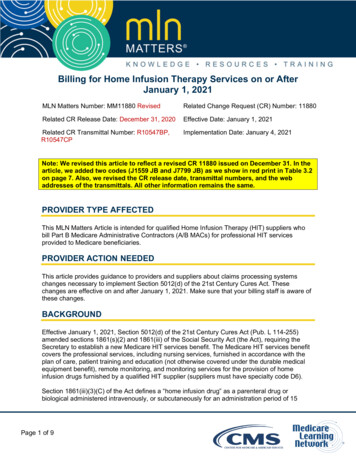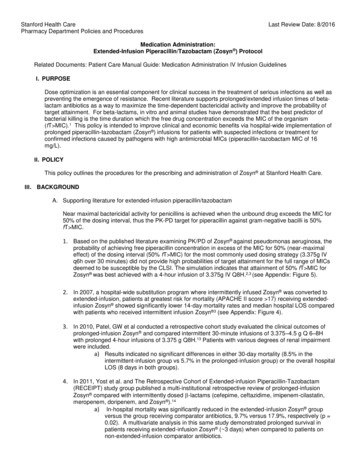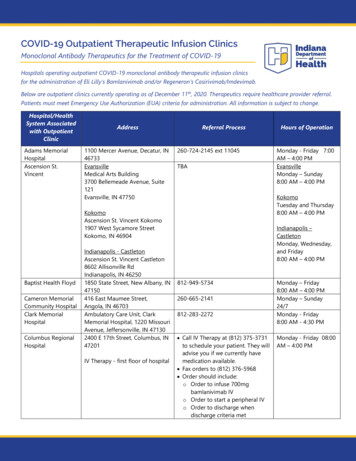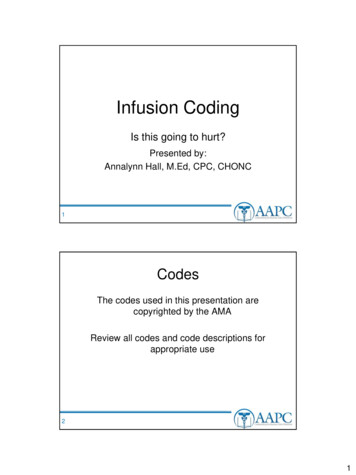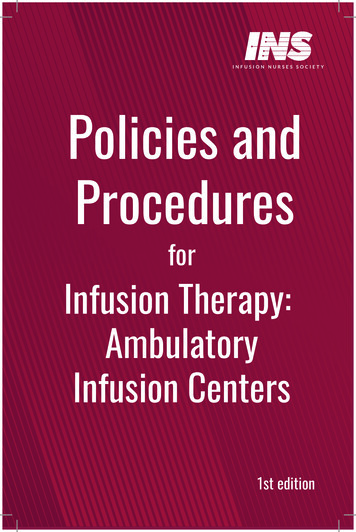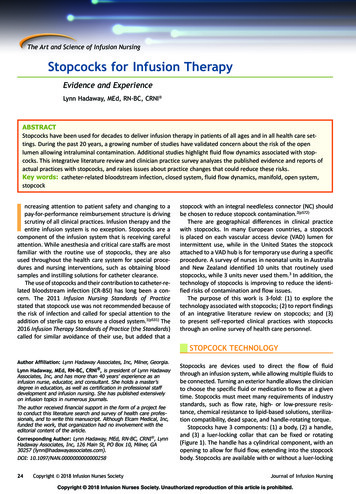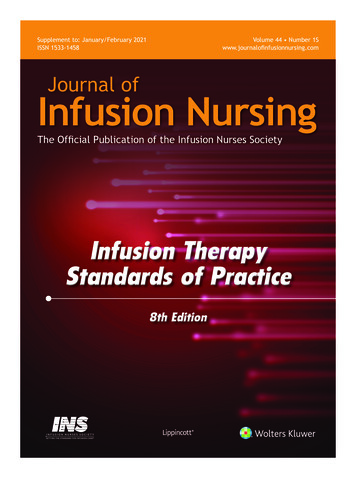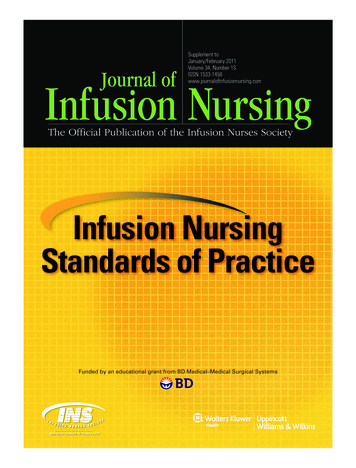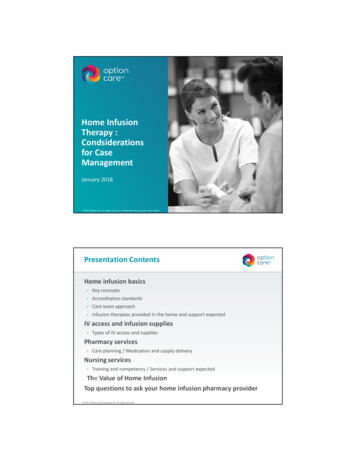
Transcription
Home InfusionTherapy :Condsiderationsfor CaseManagementJanuary 2018 2017 Option Care. All rights reserved. Confidential and proprietary information.Presentation ContentsHome infusion basics Key concepts Accreditation standards Care team approach Infusion therapies provided in the home and support expectedIV access and infusion supplies Types of IV access and suppliesPharmacy services Care planning / Medication and supply deliveryNursing services Training and competency / Services and support expectedThe Value of Home InfusionTop questions to ask your home infusion pharmacy provider 2017 Option Care Enterprises Inc. All rights reserved.Recording available at: on-information.html
Home Infusion Basics 2017 Option Care. All rights reserved. Confidential and proprietary information.Key ConceptsClinical: Pertains to how to practically manage patients, from diagnosis to treatment.It is used interchangeably with the term medical.Home care: Provides assistance in the home (personal grooming, medications, running errands,etc.).Home healthcare: Provides skilled care in the home (nursing, physical therapy, wound care, etc.).Home infusion pharmacy: Will be focus of discussion throughout the slide deck.Specialty infusion pharmacy: A home infusion pharmacy that focuses on high cost, high touch medication therapyfor patients with complex disease-states. 2017 Option Care Enterprises Inc. All rights reserved.
Key ConceptsIntravenous: \in-tra-vē-nes\ Is the delivery of medications directly into the bloodstream via a vein, usually locatedin the arm or hand. Often referenced as “IV”.Infusion therapy: \in-fü-zhen\ Involves the administration of medication through a needle or catheter into the body.Common infusion therapies include antibiotics, nutrition, chemotherapy andhydration, as well as specialty medications to treat chronic and rare diseases[e.g. hemophilia].Home infusion therapy: A safe and effective option to inpatient / outpatient hospital care. Usually involves theadministration of intravenous medications in a patient’s home or other alternatetreatment setting [ATS].Alternate treatment setting [ATS]: Usually an on-site infusion suite located in the home infusion pharmacy but could bean offsite facility affiliated with the home infusion pharmacy. 2017 Option Care Enterprises Inc. All rights reserved.Key ConceptsClinical pharmacist: A key member of the patient’s infusion care team with extensive expertise inprescribing and administering drugs, monitoring response to therapy, side effectprevention / management and education.Infusion nurse: A key member of the patient’s infusion care team with special education, training,and expertise in the administration of infusion medications, side effect prevention/ management and education. 2017 Option Care Enterprises Inc. All rights reserved.
Home Infusion PharmacyHome infusion pharmacy: Most commonly a “closed-door”, state-licensed pharmacy that specializes inproviding infusion therapies in the home or alternate treatment setting [ATS]. Home infusion pharmacies must follow licensing, regulatory and accreditationstandards required by state pharmacy and nursing boards and insurance payers.NOT all home infusion pharmacies are the same: Service territory: local vs. regional vs. national provider. IV therapies: access to and expertise with IV drugs varies greatly. Clinical services: pharmacy oversight may be limited; may not have own nursing –must subcontract [refer] to an outside agency. 2017 Option Care Enterprises Inc. All rights reserved.Home Infusion AccreditationWhat is accreditation? Accreditation involves reviewing the homeinfusion pharmacy policies and procedures,and assessing the organization’s ability tomeet regulatory requirements andstandards established by the accreditationorganization. Accreditation standards are based on theprinciples of quality assurance, evidencebased practice, medical ethics andprevention of medical error.Why is accreditation important? Accreditation allows a home infusionpharmacy to reflect its dedication andcommitment to meeting a high level ofperformance and patient care standards. 2017 Option Care Enterprises Inc. All rights reserved.
Home Infusion AccreditationThird party accreditations validate a providers commitment to meeting andexceeding quality standards. 2017 Option Care Enterprises Inc. All rights reserved.Home Infusion Pharmacy AccreditationManaging home infusion therapies requires specializedexpertise, clinical and supportive services, and specializedfacilities. Vast majority of home infusion pharmacies are accredited by 1 of 3 organizations.The accreditation standards of these organizations reflect the highest standard ofcare expected. Accreditation Commission for Health Care (ACHC)Community Health Accreditation Program (CHAP)The Joint CommissionMost commercial insurance payers require voluntary accreditation by a nationallyrecognized accreditation organization to confirm the home infusion pharmacy’scommitment to quality patient care. URAC Specialty Pharmacy AccreditationAmerican Society of Health-System Pharmacists (ASHP) 2017 Option Care Enterprises Inc. All rights reserved.
Care Team ApproachHome infusion is a highly specialized service dependent on adedicated team to provide quality, individualized patient care. Infusion nurses Clinical pharmacists Registered dietitians Support staff members [insurance specialists, pharmacy technicians]The home infusion healthcare team responsibilities include: Patient and home assessment to ensure home infusion is appropriate. Individualized care planning, coordination of care and management. Ongoing patient monitoring and reassessment. Delivery of the infusion medication and necessary supplies. Patient education and advocacy. 2017 Option Care Enterprises Inc. All rights reserved.Infusion Therapies Administered in the HomeHome infusion has been PROVEN to be a safe and effective for manydisease states and medication therapies. Core medications typically provided in the home include: Antibiotics Chemotherapy Enteral / intravenous [parenteral] nutrition Pain managementSpecialty medications commonly infused in the home include: Immune globulin Enzyme replacement therapies Bleeding disorder therapies Heart failure therapy 2017 Option Care Enterprises Inc. All rights reserved.
Medical Conditions Treated in the HomeHome infusion pharmacies work closely with physicians and otherhealthcare providers to clinically manage patients within a widerange of acute and chronic conditions, including but not limited to: Infectious diseases Nutritional / gastrointestinal disorders Cancer / blood disorders Primary immune deficiencies Hemophilia Autoimmune disorders End-stage heart failure Pre- / post-transplantation 2017 Option Care Enterprises Inc. All rights reserved.Home Infusion Center of ExcellenceHome infusion pharmacies may have a disease-specific treatmentprogram and/or a medication therapy program in place todemonstrate efficacy, optimize patient outcomes and high patientsatisfaction - usually denoted as a “Center of Excellence” [CoE]. Example: Center of Excellence – Heart Failure.A good CoE program is built on leadership, best practices,research, support and/or training for the focused disease-stateor medication therapy. Some CoE programs have a defined set of quality criteria that must be met andmonitored [e.g. hospital readmission rate, side effect rate, patient satisfaction,etc.]. Some CoE programs may simply brand themselves as a Center of Excellence formarketing purposes and may or may not meet any objective quality criteria. 2017 Option Care Enterprises Inc. All rights reserved.
Home Infusion Pharmacy SupportSupport provided by the home infusion pharmacy multidisciplinary team of clinicians and support staff may include: Care transition support (hospital liaisons) IV therapy teaching and ongoing support IV line management and education Ordering and delivering medication, supplies / equipment Dietitian consultation and nutrition monitoring Laboratory support services Medication evaluation and counseling / education Monitoring effectiveness of the infusion therapy Side effect prevention and management IV therapy monitoring and management 24-hour on-call nursing and pharmacy services 2017 Option Care Enterprises Inc. All rights reserved.IV Access and Infusion Supplies 2017 Option Care. All rights reserved. Confidential and proprietary information.
IV Vascular Access DevicesThere are many different types of IVvascular access devices available forhome infusion patients. Peripheral IVs: Short peripheraland Midlines. Central IVs: Peripherally insertedcentral catheters [PICCs], tunneled/non-tunneled catheters andimplantable ports.To ensure patient safety, clinicians needto be competent in IV vascular accessdevice [VAD] management. Intravenous Nurses Society standards Goal is to maintain the IV site device anddecrease the risk of IV site complications. Device movement, dislodgement orunintentional catheter removal. Microorganism introduction.IV Vascular Access Device 2017 Option Care Enterprises Inc. All rights reserved.IV Vascular Access DevicesSite selection for IV vascular access shallinclude assessment of: Patient’s age, condition, diagnosis and comorbidities [e.g. kidney disease].Condition of vasculature [vein condition]and surrounding skin.History of previous venipunctures [IVaccess attempts] and IV vascular accessdevices previously used.Type and duration of the infusion therapy.Patient preference.Vascular access devices are stabilizedand secured to prevent complicationsand unintentional loss of IV access. Transparent dressings and rolledbandages are not “stabilization” devices.IV Vascular Access Device 2017 Option Care Enterprises Inc. All rights reserved.
Short Peripheral IVThe most common IV access device: Less than 3” in length. Inserted into superficial vein in hand / forearm. Not appropriate for some IV therapies. No more than 2 IV attempts / per clinician. Not appropriate to use for blood draws.Duration of use: Short-term; up to 72 hours [3 days] in home Patient / caregiver can be taught to remove.Catheter care:Requires flushing every 12 hours when not in use byhome infusion patient.Risk:Phlebitis [inflammation of the vein] and infiltration[when fluid infuses into tissue surrounding the IV site].INS Standard:Rotated at RN discretionMidline Peripheral IV 2017 Option Care Enterprises Inc. All rights reserved.Midline Peripheral IVLong peripheral IV catheter: Less than 3-8” in length. Inserted into larger veins of upperarm; catheter tip extends to belowshoulder region. Not appropriate for some IVtherapies. Good for patients requiring multipleperipheral IV site changes andinfusion therapies lasting 30 days. Use cautiously in patients withhistory of blood clots [thrombosis],poor blood flow in arm, abnormalblood coagulation [e.g. hemophilia]or end-stage renal disease. Not appropriate to use forblood draws.Midline Peripheral IV 2017 Option Care Enterprises Inc. All rights reserved.
Midline Peripheral IVInsertion:Can be inserted in the home by nurse certified in Midlineplacement using ultrasound guidance. Local anesthesia not required. Does not require confirmation of catheter tip placementby chest x-ray.Duration of use: Short-term; 2-4 weeks. Nursing removes when IV discontinued.Catheter care: Requires dressing change by nursing every 5-7 days. Patient / caregiver must flush catheter every 12-24 hourswhen not in use.Risk:Dislodgement of catheter, phlebitis [lower risk than shortperipheral], and thrombosis [blood clot].Midline Peripheral IV 2017 Option Care Enterprises Inc. All rights reserved.Peripherally Inserted Central Catheter [PICC]Most common central IV catheter: 18-20” in length. Inserted into larger veins of upperarm then threaded into the centralcirculation above the heart. Good for patients requiring multipleperipheral IV site changes and infusiontherapies lasting 30 days. Use cautiously in patients with chronickidney disease.Patients with a pacemaker mustbe evaluated after insertion to assessthe integrity of the pacemaker unitand leads. Can be used for blood draws. IV insertion site should not get wet.Peripherally Inserted Central Catheter 2017 Option Care Enterprises Inc. All rights reserved.
Peripherally Inserted Central Catheter (PICC)Insertion:Can be inserted in the home by a nurse certifiedin PICC placement using ultrasound guidance. Local anesthesia not required. Must confirm location of catheter tip placement[e.g. chest x-ray].Duration of use:Long-term; up to 1 year. Nursing removes when IV discontinued.Catheter care: Requires dressing change by nursing every 5-7 days. Home infusion patient / caregiver must flushcatheter every 12-24 hours when not in use.Risk:Dislodgement of catheter, phlebitis [veininflammation], deep vein thrombosis [bloodclot] and occlusion [blocked IV flow].Peripherally Inserted Central Catheter 2017 Option Care Enterprises Inc. All rights reserved.Non-Tunneled / Tunneled IV CathetersNon-Tunneled Central IV Catheters: Inserted by a physician into large chest vein[subclavian] or a vein in the neck [internaljugular]. Length: 7-10” Short-term access; 5-7 days. Requires dressing change every 5-7 days byhome infusion nurse. Infusion nurse may remove in ATS.Tunneled Central IV Catheters: Surgically inserted into a large chest vein[superior vena cava] then tunneled under theskin, exiting through the chest or abdomen. Requires physician to insert / remove. Long-term access; months – years. 2017 Option Care Enterprises Inc. All rights reserved.Non-Tunneled Central Venous Access Device
Implanted PortImplanted central IV access device Consists of a portal body [reservoir]and IV catheter surgically implantedbeneath the skin, generally in thechest region then threaded to abovethe heart. Decreased risk of IV catheter breakageand infection; provides patient greaterfreedom with activities. Port access requires a special noncoring IV needle [e.g. Huber needle]that must be inserted by a clinician. Port may be used for lab drawsby nursing.Venous Access Port 2017 Option Care Enterprises Inc. All rights reserved.Implanted PortInsertion:Surgically placed by physician.Duration of use:Long-term; 1 years.Catheter care: Requires dressing change by nursingevery 7 days when port accessed withHuber needle. Home infusion patient / caregiver mustflush catheter every 24 hours whenHuber needle not in use but portaccessed.Risk:Infection, mechanical failure, thrombosis[blood clot], catheter migration and portseparation. 2017 Option Care Enterprises Inc. All rights reserved.
Supply / Equipment ManagementThe type of infusion therapy prescribed determines the type ofequipment and supplies the patient will need in the home. Itemstypically dispensed include: Infusion pump IV line flushes Sharps container IV tubing Catheter care suppliesGoals of home infusion pharmacy providers are to provide IVtherapies as safely and efficiently as possible. Prior to delivery, infusion equipment [e.g. pump] is cleansed and disinfected, tested foraccuracy, and undergoes comprehensive safety checks to ensure proper functioning. Infusion equipment maintenance is performed semi-annual / annual to ensure it is compliantwith the manufacturer guidelines. Most infusion pharmacies also double check the IV medication order and ancillary suppliesfor accuracy before delivery to patient. 2017 Option Care Enterprises Inc. All rights reserved.Care Transition Support 2017 Option Care. All rights reserved. Confidential and proprietary information.
Role of the Home Infusion LiaisonThe home infusion transition specialist/liaisonsupports the patient, discharge planning team,and home infusion team to assure an effectivetransition out of the hospital into the home.Some responsibilities include: Assess appropriateness for home infusion:Assess patient risks and home environment; supports riskmitigation with team. Assures patient/caregiver ability to perform therapy Educator:Sets initial expectations of patient / caregiver; providesinitial patient education. Provides clinical information to post-acute team:Sets initial expectations of patient / caregiver;provides initial patient education. Care plan development:Facilitates individualized coordination and continuity ofcare by communicating with discharging team and homeinfusion team. 2017 Option Care Enterprises Inc. All rights reserved.Role of the Home Infusion Liaison Support financial qualification processes:Gathers supporting documentation and educates patient on any financialresponsibility.Benefits of Home Infusion Liaision: Patient understand their responsibilities in the plan of care Patient has received initial teaching and provided a return demo prior to discharge Patient transition is safe and effective –pt self-manage until next clinician touch All post-acute care providers have necessary information to care for the patient Patient satisfied/anxiety reduced Proactive resolution of potential risks that may lead to readmission 2017 Option Care Enterprises Inc. All rights reserved.
2017 Option Care Enterprises Inc. All rights reserved.Clinical Pharmacy Services 2017 Option Care. All rights reserved. Confidential and proprietary information.
Role of Clinical Pharmacist in Home InfusionMission of the home infusion clinical pharmacistis to ensure patients make the best use of theirinfusion medication(s) and have the bestpossible outcomes. Some responsibilitiesinclude: Pre-admission assessment:Assesses the legal / clinical appropriateness of theprescription order; as well as patient candidacy for homeinfusion. Educator:Educates and counsels patients on use of theirmedications and ancillary therapies / supplies. Clinical monitoring:Assesses the effects of the IV infusion therapy; monitors /prevents potential drug reactions. Care plan development:Facilitates coordination and continuity of care bycommunicating with physicians, nurses and otherhealthcare providers to optimize patient care outcomes. 2017 Option Care Enterprises Inc. All rights reserved.Role of Clinical Pharmacist in Home Infusion Selects infusion device and ancillary drugs / supplies:Selects the infusion device, ancillary drugs [e.g. flushes, pre-medications, etc.] andancillary supplies [e.g. dressing kit, syringes, IV administration sets, etc.] mostappropriate for the therapy and patient needs.Benefits of Home Infusion Clinical Pharmacy Oversight: Improved patient quality of life:Skills and experience of home infusion clinical pharmacists improve patients’ lives byensuring the therapy is appropriate and safe for home use, monitors for medicationtolerance and prevents / treats adverse events. Builds better patient relationships:Home infusion clinical pharmacists work with fewer patients when compared toregular retail pharmacists; special oversight and frequent interaction builds thepatient relationship. Use clinical / medical skills:Home infusion clinical pharmacists use these skills more directly in patient care whichstrengthens his/her specialized medical knowledge which enhances patient care. 2017 Option Care Enterprises Inc. All rights reserved.
Delivery of Infusion Therapies / Supplies Home infusion pharmacies are sometimes referred to as “Closed Door Pharmacies”and are located within office buildings Prescribed medications and supplies are delivered directly to the patient througheither a courier service, such as UPS , or by the visiting nurse depending on thetherapy Patients and/or caregivers may also elect to pick-up the medication and supplies atthe home infusion pharmacy location The frequency of deliveries is largely dependent on the medication prescribed butwill typically range from weekly to monthly The patient care team will coordinate all deliveries with the patient and/or caregiveraccording to the established schedule prior to shipment The hom
IV Vascular Access Devices Site selection for IV vascular access shall include assessment of: Patient’s age, condition, diagnosis and co-morbidities [e.g. kidney disease]. Condition of vasculature [vein condition] and surrounding skin. History of previous venipunctures [IV access attempts] and I
